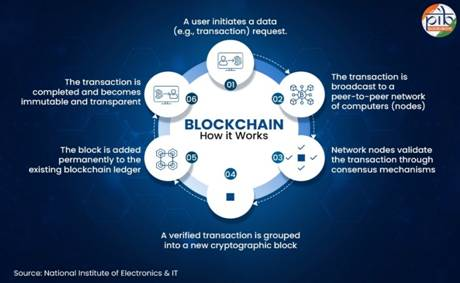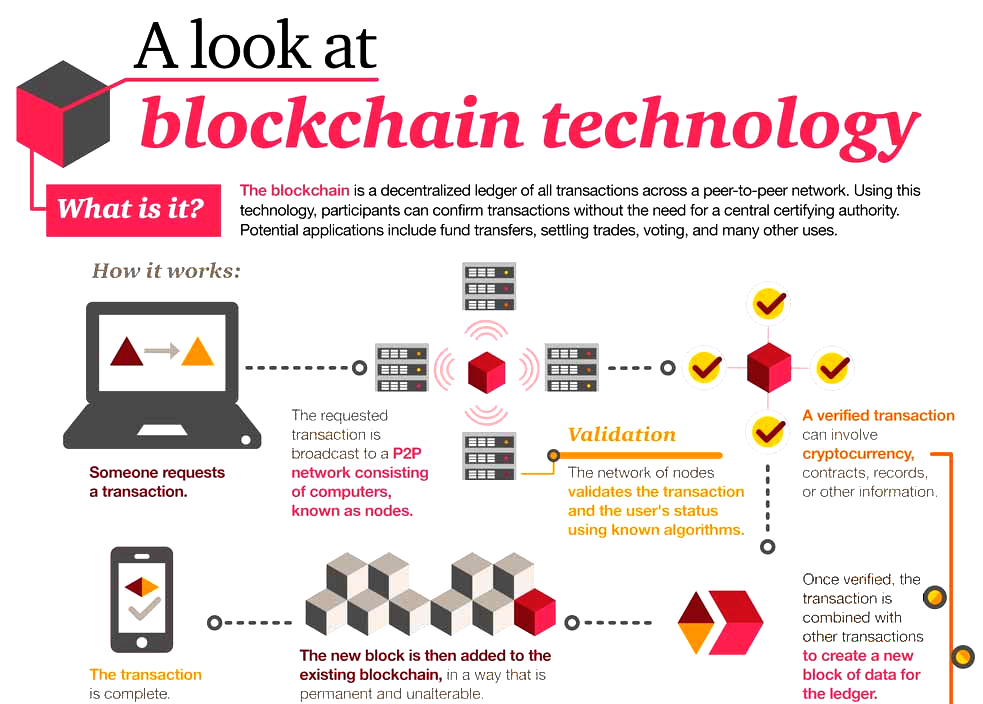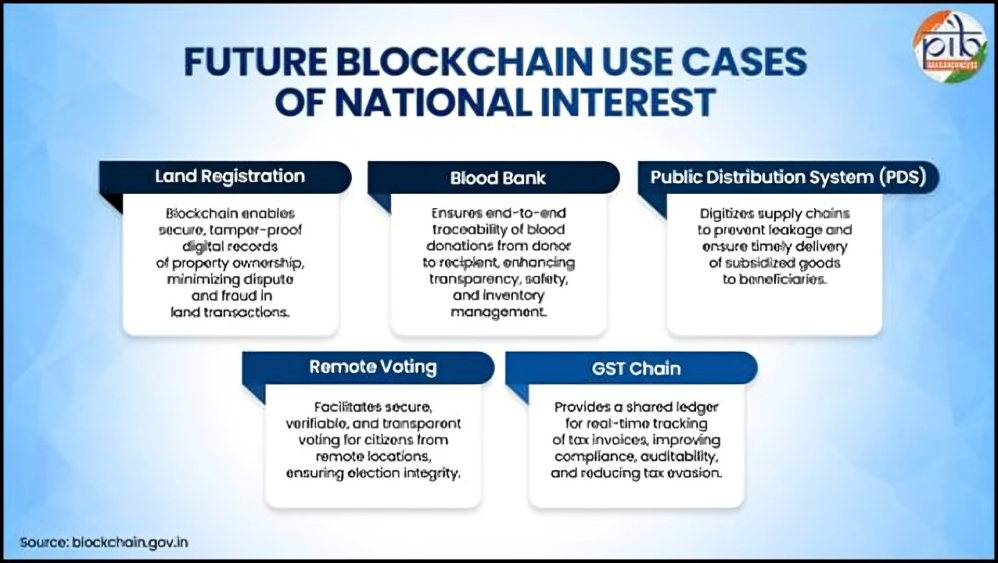Facts for UPSC Mains
India's National Blockchain Framework
- 27 Oct 2025
- 8 min read
Why in News?
Blockchain technology has become a major digital innovation with the launch of the National Blockchain Framework (NBF) in September 2024 to enhance transparency, accountability, and efficiency in public services.
- As of October 2025, over 34 crore documents have been verified using blockchain technology.
What is the National Blockchain Framework (NBF)?
NBF
- It is India’s indigenous platform to boost blockchain-based public services, providing a unified architecture for secure, transparent, and scalable solutions across government sectors.
Core Components:
- NBF’s core components include Vishvasya Blockchain Stack, NBFLite, Praamaanik, and the National Blockchain Portal.
- Vishvasya Blockchain Stack: It is an indigenous, modular platform providing the technical foundation for developing and deploying blockchain-based governance applications. Its key features are:
- Blockchain-as-a-Service (BaaS): Offers shared blockchain infrastructure for easy application deployment by government entities.
- Distributed Infrastructure: Operates via National Informatics Centre (NIC) data centres in Bhubaneswar, Pune, and Hyderabad for scalability and resilience.
- Permissioned Layer: Ensures only verified participants can validate transactions.
- Open APIs: Provides application programming interface (APIs) and modules for authentication and data exchange.
- NBFLite: A sandbox version of the blockchain stack for startups, academia, and researchers to prototype applications in a controlled environment.
- Praamaanik: An innovative solution that uses blockchain to verify the authenticity and source of mobile applications, protecting users from fraud.
- National Blockchain Portal: A central platform outlining India’s strategic approach and supporting cross-sector adoption.
- Vishvasya Blockchain Stack: It is an indigenous, modular platform providing the technical foundation for developing and deploying blockchain-based governance applications. Its key features are:
NBF Transforming Digital Governance in India:
- Certificates and Document Chain: Securely stores academic documents and government certificates (caste, income etc), with over 34 crore documents verified through the platform.
- Logistics Chain: Tracks goods movement like Karnataka’s Aushada system, ensuring drug authenticity, enabling patient verification, and curbing spurious drugs.
- Judiciary and ICJS Chain: Provides a secure, immutable record of judicial data, enabling electronic delivery of summons and orders.
- The Inter-operable Criminal Justice System (ICJS) unifies the criminal justice ecosystem for case records, evidence, and judicial documents.
- Property Chain: Securely records property transactions, providing full ownership history, reducing litigation, and speeding up dispute resolution.
Blockchain
- About: Blockchain is a distributed, immutable, and transparent digital ledger that records transactions securely across multiple computers (nodes).
- It removes the need for intermediaries by enabling verifiable trust among participants.
- Features: Key features include decentralization, immutability, transparency, and security—all crucial for reliable governance systems.
Key Initiatives Promoting Blockchain Adoption in India
- National Strategy on Blockchain: The National Strategy on Blockchain by MeitY outlines India’s roadmap for blockchain development, addressing challenges and setting short- and long-term goals for its integration across sectors.
- Centre of Excellence (CoE) in Blockchain: NIC has set up a CoE to offer consultancy, training, and support for pilot blockchain projects before large-scale implementation.
- TRAI’s Role: Telecom Regulatory Authority of India (TRAI) has integrated Distributed Ledger Technology (DLT) to curb spam and fraud in SMS transmission.
- RBI’s Blockchain Initiatives: RBI conducted a pilot for Digital Rupee (e₹) in retail transactions to promote traceable, instant, and inclusive payment systems using blockchain.
- NSDL’s Adoption of Blockchain: National Securities Depositories Limited (NSDL) developed the Debenture Covenant Monitoring System to track asset charges and covenants on a tamper-proof ledger, boosting investor confidence.
How is India Building a Blockchain-Ready Workforce?
- Skill Development: Over 214 programs have trained 21,000+ government officials in emerging technologies including blockchain.
- Post Graduate Diploma in FinTech & Blockchain: Offers 900-hour training on blockchain, fintech, AI, cybersecurity, and regulatory frameworks.
- BLEND programme by C-DAC: Blockchain Technology and Application Development (BLEND) is an online course for engineering students and professionals to learn blockchain architecture and real-world applications.
- FutureSkills PRIME: MeitY-backed initiative for upskilling IT manpower in 10 emerging technologies including blockchain.
Conclusion
Aligned with Digital India and Aatmanirbhar Bharat, the National Blockchain Framework drives trust-based digital governance, uniting indigenous technology, regulation, and skills to make India a global blockchain leader.
|
Drishti Mains Question: Q. Discuss the significance of the National Blockchain Framework (NBF) in promoting trust-based digital governance in India. |
Frequently Asked Questions (FAQs)
1. What is the National Blockchain Framework (NBF)?
NBF is India’s indigenous blockchain platform that ensures secure, transparent, and scalable e-governance solutions across sectors.
2. What are the core components of NBF?
Vishvasya Blockchain Stack, NBFLite, Praamaanik, and the National Blockchain Portal are its four main components.
3. How is India developing blockchain skills?
Through programs like FutureSkills PRIME, BLEND, and Post Graduate Diploma in FinTech & Blockchain, over 21,000 officials have been trained in emerging technologies.
UPSC Civil Services Examination, Previous Year Question (PYQ)
Prelims
Q. With reference to “Blockchain Technology”, consider the following statements: (2020)
- It is a public ledger that everyone can inspect, but which no single user controls.
- The structure and design of blockchain is such that all the data in it are about cryptocurrency only.
- Applications that depend on basic features of blockchain can be developed without anybody’s permission.
Which of the statements given above is/are correct?
(a) 1 only
(b) 1 and 2 only
(c) 2 only
(d) 1 and 3 only
Ans: (d)
Q. In India, the term “Public Key Infrastructure” is used in the context of (2020)
(a) Digital security infrastructure
(b) Food security infrastructure
(c) Health care and education infrastructure
(d) Telecommunication and transportation infrastructure
Ans: (a)
Q. With reference to ‘Bitcoins’, sometimes seen in the news which of the following statements is/are correct? (2016)
- Bitcoins are tracked by the Central Banks of the countries.
- Anyone with a Bitcoin address can send and receive Bitcoins from anyone else with a Bitcoin address.
- Online payments can be sent without either side knowing the identity of the other.
Select the correct answer using the code given below:
(a) 1 and 2 only
(b) 2 and 3 only
(c) 3 only
(d) 1, 2 and 3
Ans: (b)
Mains
Q. Discuss how emerging technologies and globalisation contribute to money laundering. Elaborate measures to tackle the problem of money laundering both at national and international levels? (2020)
Q. What is Cryptocurrency? How does it affect global society? Has it been affecting Indian society also? (2019)









